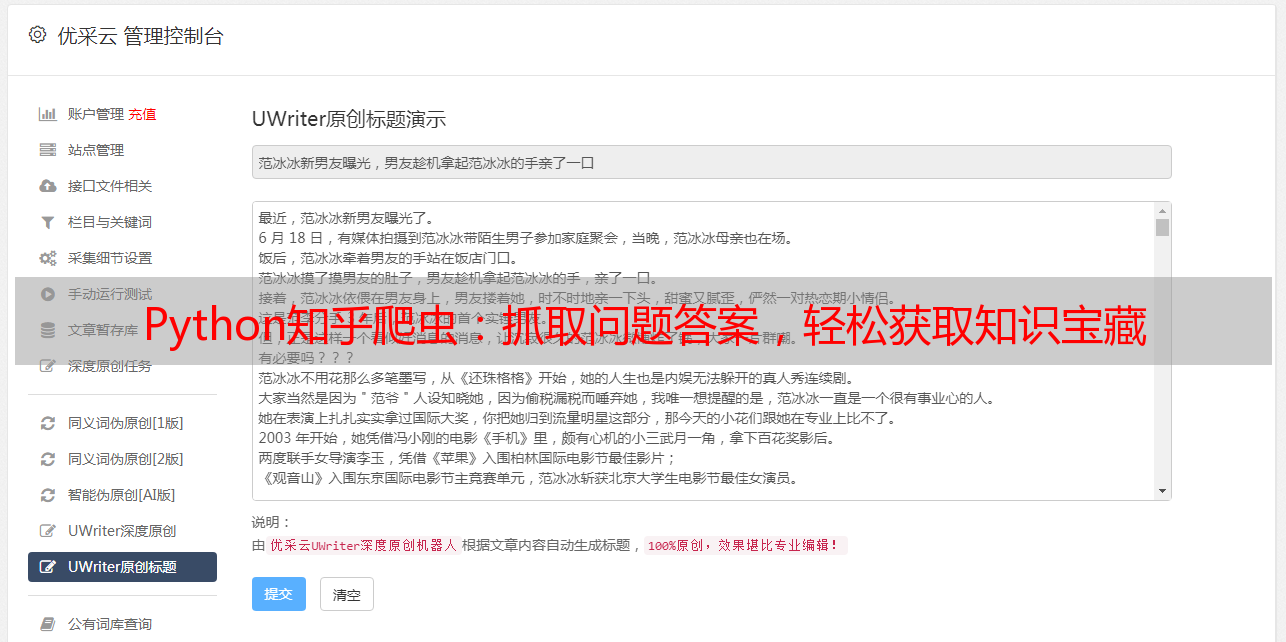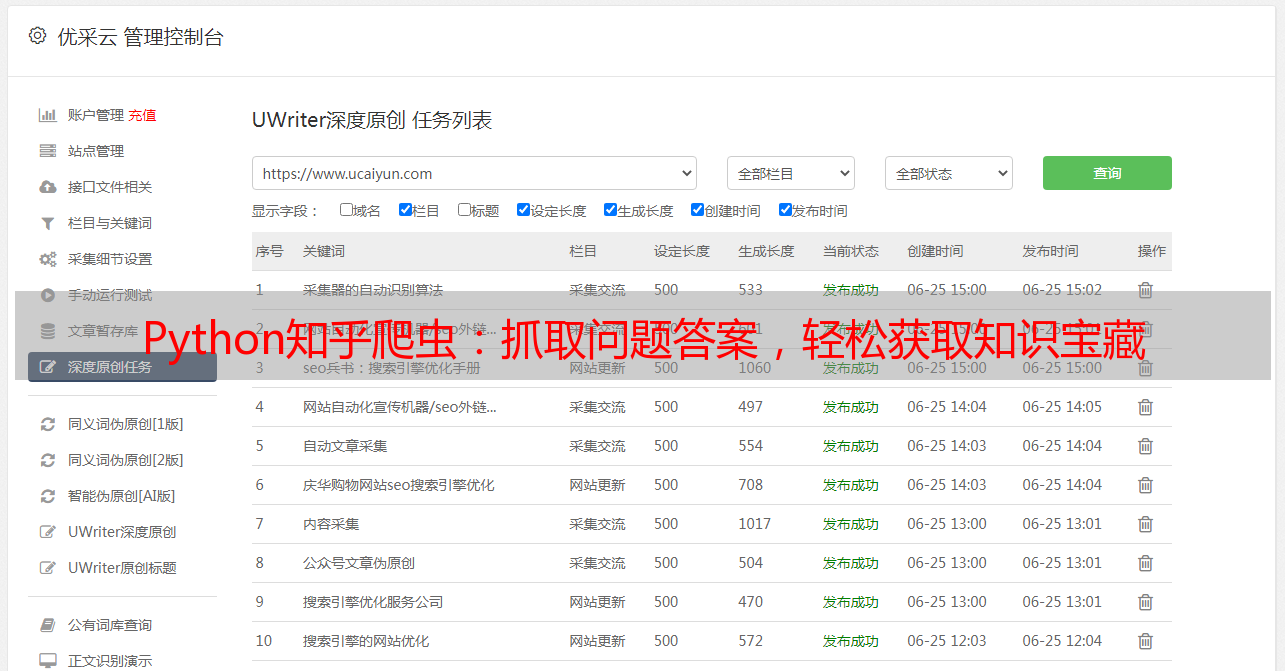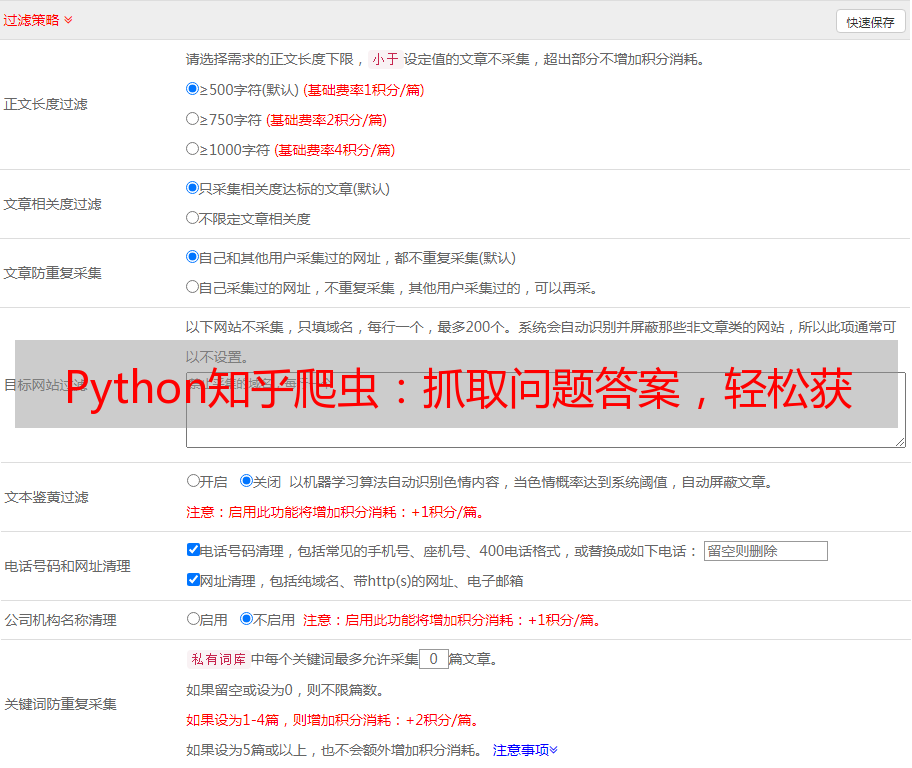Python知乎爬虫:抓取问题答案,轻松获取知识宝藏
优采云 发布时间: 2023-03-25 17:16知乎是一个充满智慧和思想碰撞的社交平台,每天都有海量的高质量问题和答案被发布。但是,你是否曾想过将这些问题和答案进行整理,或者将它们用于其他用途?这时候,知乎爬虫就派上用场了。本文将介绍如何使用Python编写一个简单的知乎爬虫,来获取知乎上的问题和答案。
1.爬虫基础
在开始编写爬虫之前,我们需要先了解一些基础知识。首先是HTTP协议,它是Web通信中最重要的协议之一。当我们在浏览器中输入网址时,浏览器会向服务器发送HTTP请求,并接收服务器返回的HTTP响应。其中,请求包含请求头和请求体两部分内容,响应也包含响应头和响应体两部分内容。我们可以通过Python中的`requests`库来模拟HTTP请求,并获取响应内容。
2.获取问题列表
知乎上有很多话题和问题,首先我们需要获取到问题列表。使用`requests`库发送GET请求即可获取到页面源代码。接下来,我们需要使用正则表达式或BeautifulSoup库来解析HTML源代码,并提取出感兴趣的信息。在这里,我们可以使用BeautifulSoup库来获取问题列表中每个问题的链接。
python
import requests
from bs4 import BeautifulSoup
url ="https://www.zhihu.com/topic/19552832/hot"
headers ={
'User-Agent':'Mozilla/5.0(Windows NT 10.0; Win64; x64) AppleWebKit/537.36 (KHTML, like Gecko) Chrome/58.0.3029.110 Safari/537.3'}
response = requests.get(url, headers=headers)
soup = BeautifulSoup(response.text,'lxml')
questions = soup.find_all('a', class_='question_link')
for question in questions:
print(question.get('href'))
3.获取问题详情和答案
我们已经获得了问题列表中每个问题的链接,现在需要进入每个问题页面,获取问题详情和答案。可以使用正则表达式或BeautifulSoup库来解析HTML源代码,并提取出感兴趣的信息。在这里,我们可以使用BeautifulSoup库来获取问题标题、描述和答案。
python
import requests
from bs4 import BeautifulSoup
url ="https://www.zhihu.com/question/37787176"
headers ={
'User-Agent':'Mozilla/5.0(Windows NT 10.0; Win64; x64) AppleWebKit/537.36 (KHTML, like Gecko) Chrome/58.0.3029.110 Safari/537.3'}
response = requests.get(url, headers=headers)
soup = BeautifulSoup(response.text,'lxml')
title = soup.find('h1', class_='QuestionHeader-title').text.strip()
description = soup.find('div', class_='QuestionHeader-detail').text.strip()
answers = soup.find_all('div', class_='RichContent-inner')
for answer in answers:
print(answer.text.strip())
4.存储数据
获取到问题和答案后,我们可以将它们存储到本地文件或数据库中。在这里,我们将使用Python内置的`csv`模块来将数据存储到CSV文件中。
python
import requests
from bs4 import BeautifulSoup
import csv
url ="https://www.zhihu.com/question/37787176"
headers ={
'User-Agent':'Mozilla/5.0(Windows NT 10.0; Win64; x64) AppleWebKit/537.36 (KHTML, like Gecko) Chrome/58.0.3029.110 Safari/537.3'}
response = requests.get(url, headers=headers)
soup = BeautifulSoup(response.text,'lxml')
title = soup.find('h1', class_='QuestionHeader-title').text.strip()
description = soup.find('div', class_='QuestionHeader-detail').text.strip()
answers = soup.find_all('div', class_='RichContent-inner')
with open('zhihu.csv','a', newline='', encoding='utf-8') as csvfile:
writer = csv.writer(csvfile)
writer.writerow(['问题标题','问题描述','答案'])
for answer in answers:
writer.writerow([title, description, answer.text.strip()])
5.总结
现在,我们已经成功编写了一个简单的知乎爬虫,用于获取知乎上的问题和答案。通过该爬虫,我们可以轻松地获取知乎上的各种信息,并进行分析处理。当然,在爬取数据的过程中,我们需要注意遵守知乎的相关规定和法律法规,不得擅自使用他人信息,否则可能会遭受法律风险。





